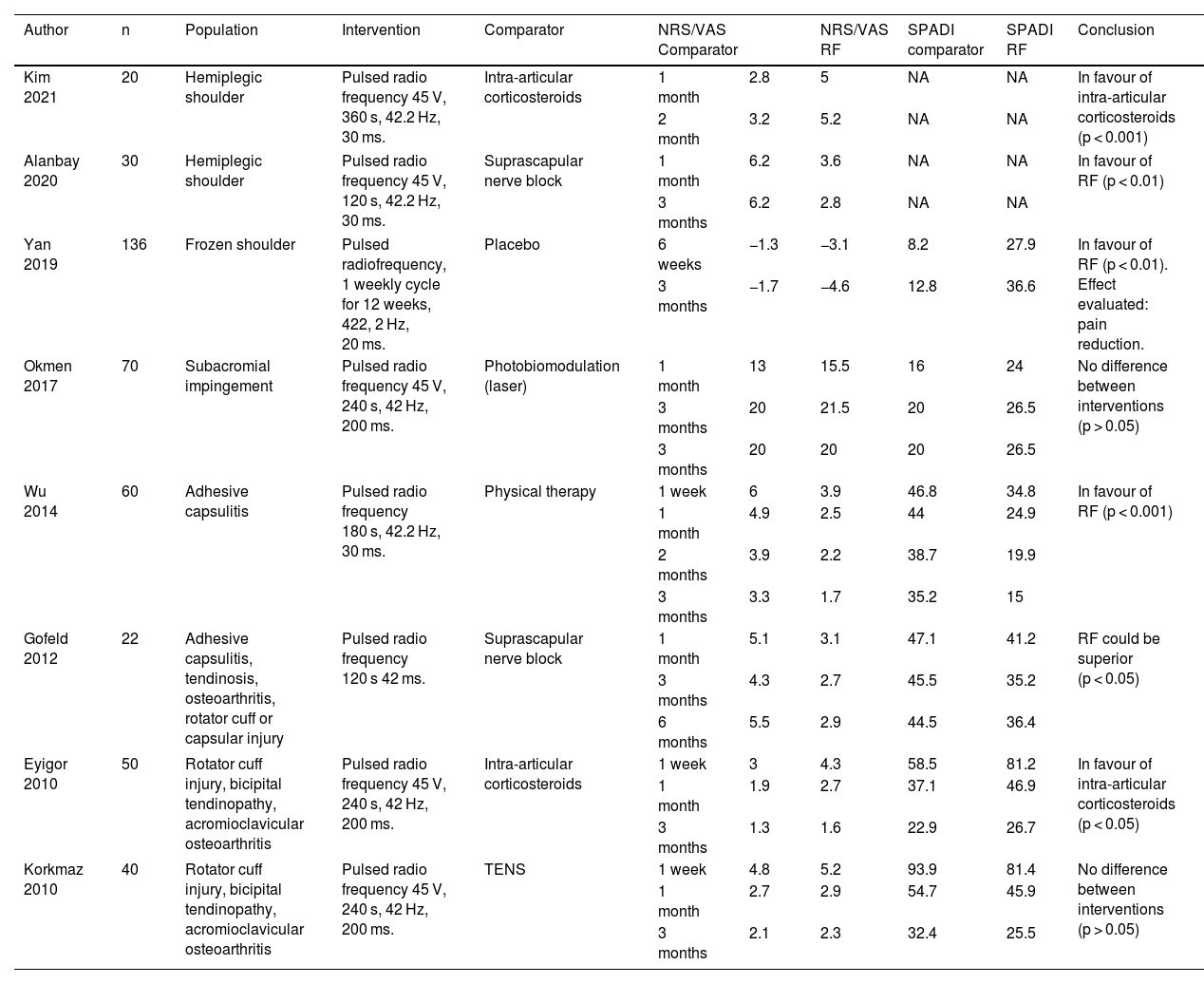Chronic shoulder pain is highly prevalent in the general population. Many different analgesic strategies have been described, including radiofrequency treatment to the suprascapular nerve (RFS); however, the effectiveness this approach remains unclear, and no strong recommendation can be made. The aim of this systematic review is to analyse the latest clinical trials evaluating the effectiveness of RFS techniques applied to the suprascapular nerve in terms of management of chronic shoulder pain, post-procedural functionality, and adverse effects.
MethodsWe performed a systematic review of clinical trials retrieved from Medline, Embase and the CENTRAL databases. We included trials comparing RFS with other strategies, including placebo, that had as their primary outcome measures pain rated on a visual analogue scale, functionality rated on a shoulder pain and disability index (SPADI), and the incidence of adverse events. Risk of bias was analysed using the Cochrane RoB2 tool. Evidence was analysed using a random effects model and heterogeneity was quantified using the I2 test.
ResultsWe identified 3030 trials, of which 8 met the inclusion criteria (n = 408). Seven had a high risk of bias. Pain intensity at 1 and 3 months was lower in patients receiving RFS, with a standardised mean difference (SMD) of −0.9 (95% CI [−1.1, 0.33], p = 0.29; I2 88%, p < 0.001) and −1.17 (95% CI [−2.49, 0.14], p = 0.08; I2 97%, p < 0.001), respectively. Functional compromise at 1 and 3 months decreased in patients receiving RFS, with an SMD of −0.31 (95% CI [−0.91, 0.29], p = 0.31; I2 80%, p < 0.001) and −1.54 (95% CI [−3.26, 0.19], p = 0.08; I2 98%, p < 0.001), respectively. No RFS-related adverse events were described.
ConclusionThe evidence suggests that RFS reduces pain and improves functionality. However, the certainty of the evidence is low.
El dolor crónico de hombro resulta altamente prevalente en la población general. Se han descrito múltiples estrategias analgésicas incluyendo la radiofrecuencia del nervio supraescapular (RFS) sin lograr identificar su efectividad al momento de generar una recomendación. El objetivo de esta revisión sistemática es actualizar y analizar los ensayos clínicos en términos de efectividad para el control del dolor, funcionalidad y efectos adversos de la radiofrecuencia del nervio supraescapular en pacientes con dolor crónico de hombro.
MétodosSe realizó una revisión sistemática de la literatura en Medline, Embase y CENTRAL buscando ensayos clínicos que compararan la radiofrecuencia del nervio supraescapular con otras estrategias incluido placebo e incluyeran como resultado principal la intensidad del dolor medida en una escala visual análoga, la funcionalidad por un índice de dolor y discapacidad del hombro (SPADI) y cuantificaran la ocurrencia de eventos adversos. Se analizó el riesgo de sesgo mediante la herramienta RoB2 de Cochrane. Se analizó la evidencia mediante un modelo de efectos aleatorios y se cuantificó la heterogeneidad mediante la prueba del I2.
ResultadosSe identificaron 3030 publicaciones de las cuales 8 cumplieron con los criterios de inclusión (n = 408). Siete tenían alto riesgo de sesgo. La intensidad del dolor al mes y a los tres meses fue menor para la RFS, SMD −0.9 (IC 95% [−1.1, 0.33], p = 0.29; I2 88%, p < 0.001) y SMD −1.17 (IC 95% [−2.49, 0.14], p = 0.08; I2 97%, p < 0.001), respectivamente. El compromiso en la funcionalidad al mes y a los tres meses disminuyó en aquellos sometidos a RFS, SMD −0.31 (IC 95% [−0.91, 0.29], p = 0.31; I2 80%, p < 0.001) y SMD −1.54 (IC 95% [−3.26, 0.19], p = 0.08; I2 98%, p < 0.001), respectivamente. No se describió la ocurrencia de eventos adversos relacionados con la RFS.
ConclusiónLa RFS sugiere un beneficio para la disminución del dolor y mejoría de la funcionalidad. Sin embargo, la certeza de los resultados es baja.












